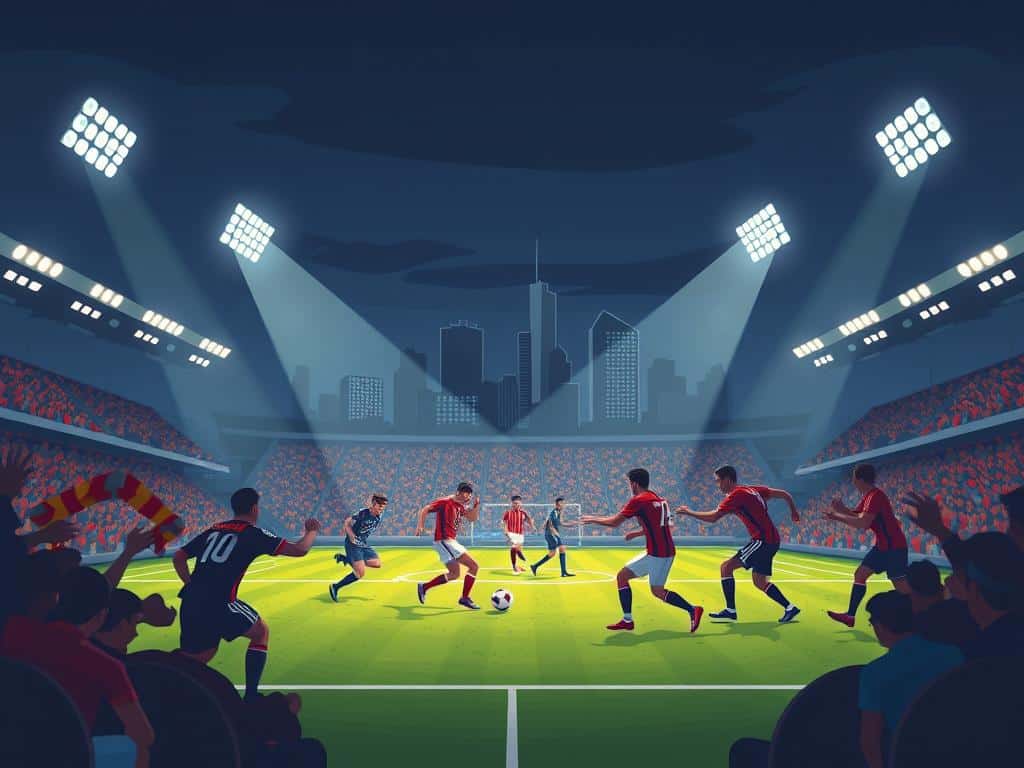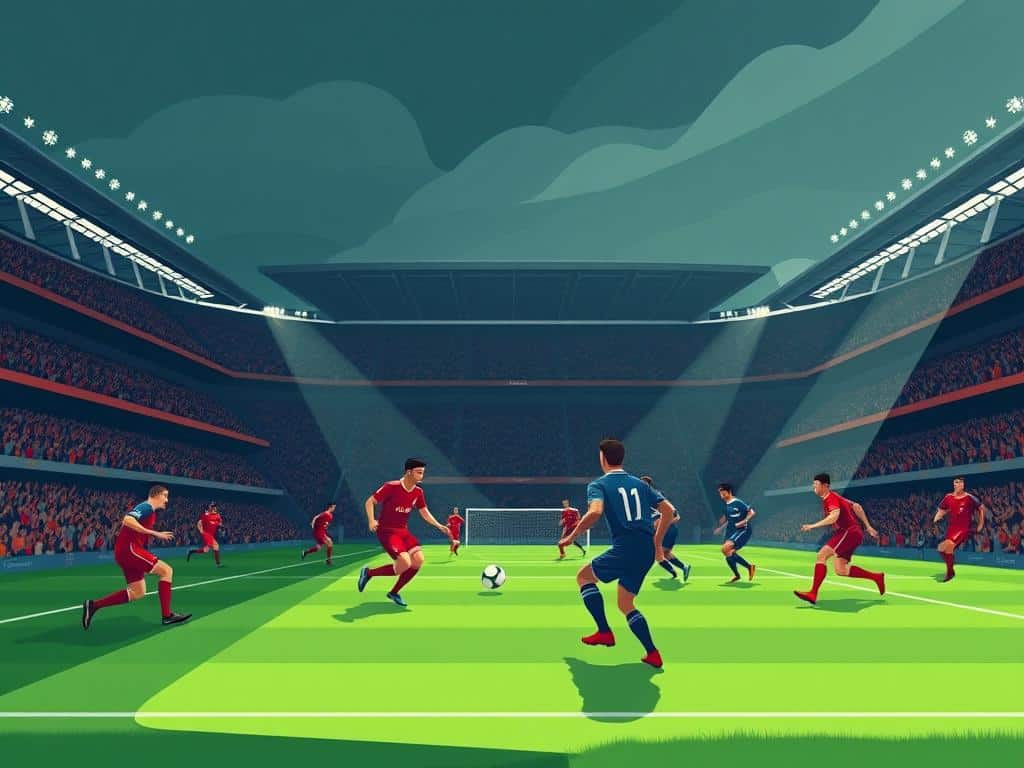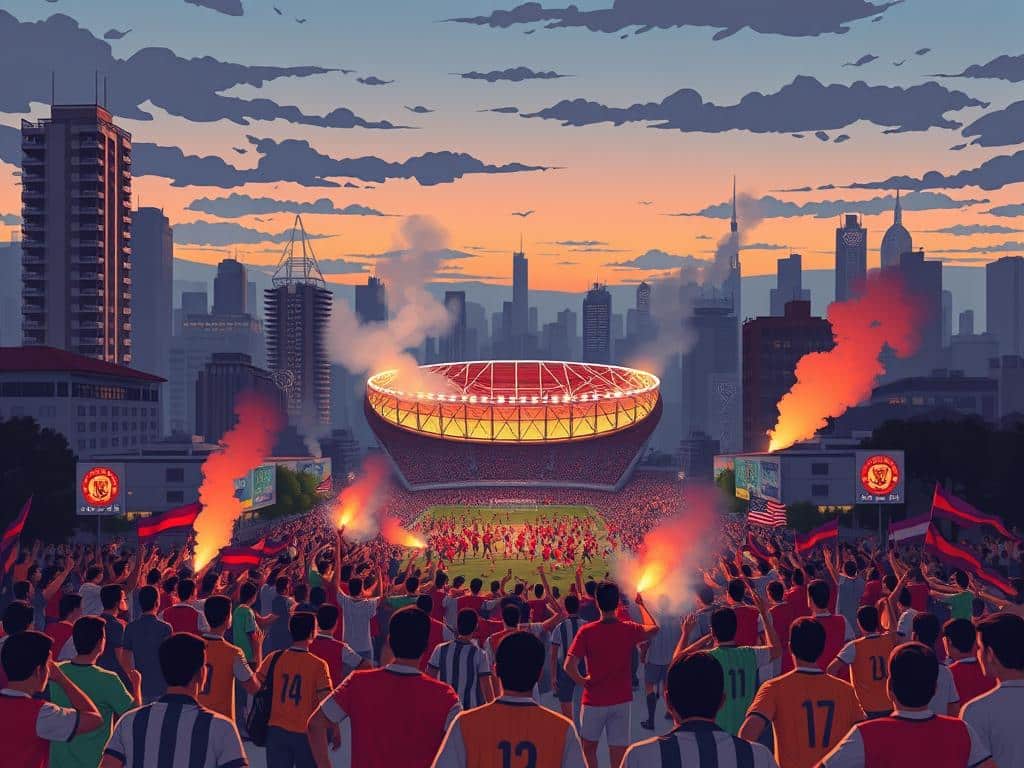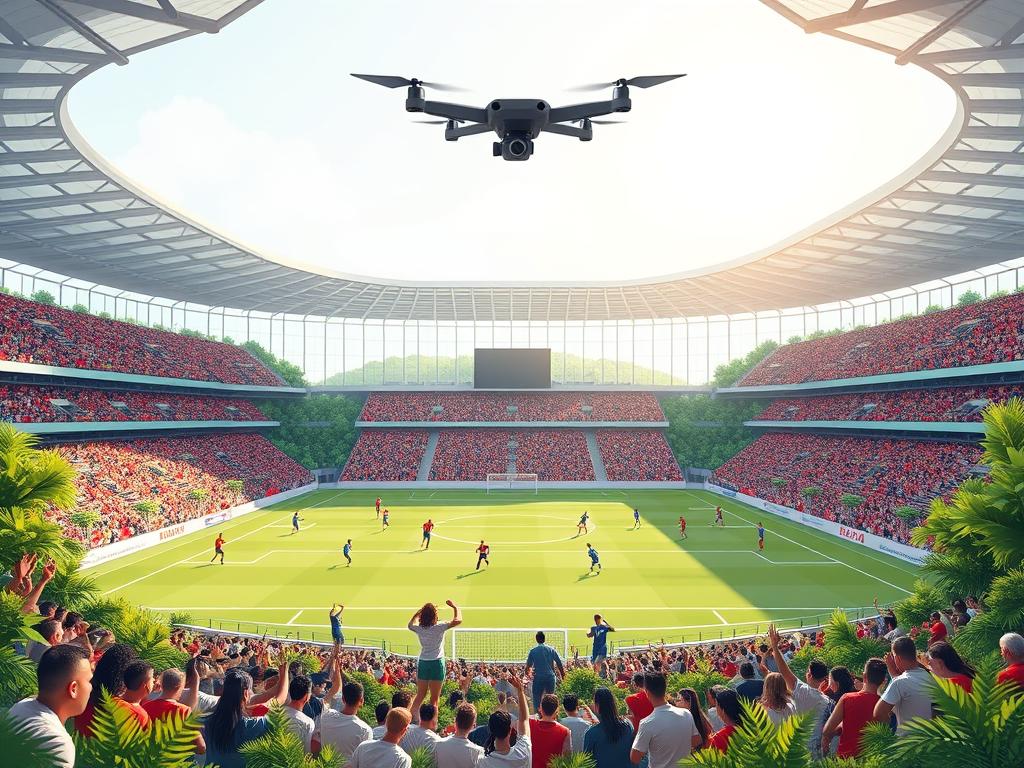I still get goosebumps remembering a derby where an ordinary street felt like a stadium; that scene shows exactly how rival pride turns neighborhoods into stages.
On matchday you see more than players and kits—Sky Sports and BT Sport beam the atmosphere worldwide while Nike, Adidas, and Heineken turn identity into visible culture.
I’ll point to Manchester, North London, and Liverpool as clear examples where industrial history and local class lines echo in chants, pub gatherings, and weekend commerce.
Expect crisp, practical insight: why fans spill into bars, how transport strains mirror civic rhythms, and why a local win nudges pride at work and school for days.
Key Takeaways
- Derbies act as civic mirrors: teams reflect a city’s history and modern change.
- Broadcasts and brands shape the mood you feel before kickoff.
- Matchdays boost small businesses and local social life.
- Neighborhood identity survives in chants, rituals, and rituals carried home.
- You can read a rivalry by watching streets, pubs, and fan behavior—not just the scoreboard.
Why derby days define urban identity in English football
On derby morning the streets begin to tell a story in scarves and songs. You sense the city before you reach the ground.
Derby days translate local pride into visible identity. Nearby clubs trade local customs, accents, and banners. Broadcasters and brands then frame those moments for a wider audience.
I watch rivalries surface in tiny details—murals, pub rituals, transit colors on scarves. In english football, owning bragging rights in Manchester or North London signals more than a win; it asserts a place in the city’s narrative.
- Streets, pubs, and plazas turn into shared stages.
- Fans of different neighborhoods wear history on flags and chants.
- The match acts as a public measure of local pride.
| Stage | Visible Signs | Effect on identity |
|---|---|---|
| Neighborhood | Murals, barber shops, pub flags | Roots local memory in daily life |
| Stadium | Tifos, home end, away section | Amplifies sense of home and belonging |
| Broadcast | Derby kits, camera crowd shots, hype | Frames city character for global audiences |
History that lives on the pitch: rivalries as city memory
Decades of industry and migration leave fingerprints that show up on matchday. I watch banners and chants and read them like local records.
Industrial roots forged early club loyalties: dockyards, mills, and rail workers formed fan bases that kept local identity alive. Those workplace ties still echo in songs and pre-match routines.
Across a century, promotions, relegations, and ownership changes often paralleled urban cycles. Decline, regeneration, and new investment show up in stadium upgrades and in derby intensity.
- Factory whistles once set Saturday routines; fans still time their weekends by that rhythm.
- Shared legend and heartbreak pass from parent to child on the walk to the ground.
- Digital archives—EA Sports highlights and documentaries—compress a century of memory into a single clip.
Industrial roots, class divides, and the birth of city-wide competition
In english football, terraces once mapped class lines: standing ends and main stands told different stories about who the club served.
When club fortunes mirror urban transformation across a century
Take Manchester: Manchester United’s long-era legacy sits beside a neighbor’s modern investment. That contrast reads like a city moving from industrial heritage to a global economy.
| Era | Visible sign | Urban meaning |
|---|---|---|
| Early 20th century | Workplace affiliations, local songs | Community identity built around industry |
| Mid century | Promotions/relegations, local rivalries | Reflection of city boom and bust |
| Modern era | Stadium renovation, global branding | Regeneration and outside investment |
The psychology of rivalry: home, doubles, and the “uncanny” city mirror
A local clash can feel less like a game and more like a personal crossroads for identity. I see this in tiny moments: a shouted chant, a neighbor’s scarf, a headline on Sky Sports that sharpens every mood.

Freud, Rank, and unsettling doubles
Freud’s “uncanny” explains why a rival can feel like an unsettling double that threatens your sense of home. Otto Rank adds that doubles first reassure then alarm—success across the street becomes a threat to your place.
In-group vs. out-group dynamics
Stadiums act like group tests. Chants and rituals mark belonging; boos enforce the boundary. Clubs now hire sport psychologists to manage pressure and hostile atmospheres.
Tribal belonging: why wins soothe and losses sting
- Derbies feel personal because a rival is familiar yet different, like a city twin.
- The narcissism of small differences sharpens edges: shared streets, different scarves.
- On matchday your body reacts—adrenaline spikes, focus narrows, tiny events carry big meaning.
In short: football rivalries cut deep because they probe who you are as a fan and what your community claims as home.
Manchester’s split screen: Manchester United, Manchester City, and a city’s self-image
Walk through Manchester and you can read two narratives in the colors people wear and the billboards they pass. I see tradition and new money arguing on the same streets.
Legacy vs. modern investment: two clubs, two narratives
Manchester United carries Ferguson-era prestige: global tours, a deep history, and an identity built over a century. That legacy reads like civic memory.
Manchester City reflects takeover-era investment: meticulous planning, stadium renewal, and branding that says the city is growing new wealth.
| Aspect | United | City |
|---|---|---|
| Image | Heritage and global fanbase | Modern facilities and strategy |
| Moment | Legacy trophies and old narratives | Aguero’s title, Haaland’s finishing |
| Urban effect | Civic pride tied to history | Investor-driven city identity |
Manchester derby pressure cookers: from Aguero’s title moment to Haaland’s efficiency
The manchester derby compresses civic stakes into 90 minutes. Aguero’s stoppage-time winner rewrote a season and the city’s story.
Haaland’s cold finishing under pressure shows psychology meeting tactics. Fans treat these matches like public holidays—bragging rights that last beyond the final whistle.
- You can read the city through these clubs: one is heritage, one is modern muscle.
- Broadcasters like Sky Sports and BT amplify every plot twist.
North London contrasts: Arsenal, Tottenham, and the culture of the North London Derby
The North London derby compresses neighborhood memory into ninety minutes of pulse and pride.
I watch two clubs trade character on a single street: Arsenal’s polish and measured tradition sits opposite Tottenham’s restless energy and fan-born momentum.
You feel north london in small things — the station-to-stadium walks, café chatter, and mural art that mark match routines. Older fans keep the history alive; younger supporters remix it with bold banners and viral clips.
- Cultural snapshot: Arsenal’s decorum vs. Tottenham’s ambition fuels the local narrative.
- Kits, tifos, and broadcast shots export neighborhood pride worldwide.
- On derby week, home turf feels sacred; every block carries past wins and losses.
| Aspect | Arsenal | Tottenham |
|---|---|---|
| Style | Polished tradition | Energetic, fan-driven momentum |
| Matchday feel | Measured rituals, formal chants | Boisterous crowds, spontaneous songs |
| Urban signal | Established identity, quiet pride | Restless ambition, visible hustle |
Merseyside Derby and the fabric of Liverpool
In Liverpool the derby reads like a city conversation, spoken across terraces and kitchen tables.
Everton’s “people’s club” claim under David Moyes was a public push at identity and pride. It directly challenged Liverpool’s wider dominance and gave working neighborhoods a voice. That claim shaped talk in pubs and on news slots on Sky Sports and BT Sport.

With Anfield and Goodison a short walk apart, families often split colors. I’ve seen siblings trade barbs at Sunday dinner. Neighbors sing from opposing gardens. Matchday business swells—cafés, shops, and transport routes lean into the crowd.
On the pitch the derby shows grit over glamour: tight marking, second-ball fights, last-ditch blocks. Fans reward effort as much as flair. Community charity games and joint drives prove the two clubs can still pull together for the city.
- The merseyside derby runs through living rooms and docks.
- Bragging rights last long after a single match ends.
- For a quick primer on classic local clashes see notable historical rivalries.
how soccer rivalries shape cities through economics, infrastructure, and branding
A derby brings a clear, immediate return on a city’s weekend economy—measured in takings, bookings, and footfall. I see pubs and hotels report measurable lifts, with transit runs booked to capacity and local shops selling out of scarves.
Matchday economies: pubs, transport, and retail booms
Derby weekends lift local revenue: bars and restaurants report higher takings, hotels fill with visiting fans, and retailers sell limited-run kits from Nike, Adidas, Puma, and Umbro.
Stadium upgrades and fan tech as modernization signals
Clubs use naming deals, EA Sports partnerships, and improved Wi‑Fi to fund new stands and fan screens. These projects act as visible civic upgrades—better wayfinding, safer exits, and inclusive zones that benefit the wider public.
Global exposure: broadcasters and brands
Sky Sports and BT Sport turn local matches into global showcases. Sponsors like Heineken and Barclays activate fan zones that double as tourist ads, exporting the city’s sound, color, and culture to millions.
| Impact | Example | Lasting benefit |
|---|---|---|
| Local revenue | Pub takings, hotel bookings | Small business growth |
| Infrastructure | Stadium rehab, transit upgrades | Improved city access |
| Branding | Broadcasts, kit drops | Global city image |
Media and social platforms as rivalry amplifiers
Broadcasts and feeds now build the story. Broadcast frames and social feeds turn local clashes into serialized drama. That blend decides what you feel before the first whistle and long after the final whistle.
Sky Sports-era narratives and documentary storytelling
TV creates theater. Slow motion, archive clips, and punditry give matches weight and context.
Documentaries and club series binge seasons into arcs. A single tackle becomes a plot twist when editors set it that way.
Social banter, mimicry, and identity performance beyond the stadium
On platforms, fans trade memes, chant clips, and edits that spread fast. Mimicry stings: when a rival copies your song, your group feels ownership slip.
- TV: builds drama with data and slow shots.
- Docs: add backstory that deepens rivalry meaning.
- Social: makes bragging and highlights portable—manchester united trends can hijack timelines after a thriller.
| Platform | Main effect | Lasting impact |
|---|---|---|
| Television | Framing, pundit narratives | Wider sense of competition |
| Documentaries | Serialized backstory | Deeper fan investment |
| Social media | Memes and instant highlights | Global echo of a local game |
Emerging and non-local conflicts reshaping English football rivalries
These days, televised contests can make distant clubs feel like next-door rivals. I see competition move from streets to schedules. Fans follow tactical duels and title races as eagerly as local bragging rights.
Manchester City vs. Liverpool: modern excellence and competing northern identities
City vs. Liverpool now reads as a contest of systems and regional image. Pep’s precise plans face Klopp’s intense pressing. Those matches recast northern pride for a global audience.
Chelsea vs. West Ham: gentrification, borough pride, and shifting London lines
Chelsea’s skyline-linked branding meets West Ham’s working‑class magnetism. The clash highlights who claims borough identity in a changing urban landscape.
When “history” meets “new money”: authenticity debates and borrowed identities
Fans argue over earned legacy versus purchased success. Youth audiences intensify that debate through clips, tactic threads, and memes. A single match can tip public opinion about which club feels authentic.
Why this matters
- Not all heat is local—titles and media now stoke modern rivalries.
- Success turns repeated fixtures into cultural rituals with their own songs and memes.
- Even manchester united gets woven into new triangles as form and fixtures shift.
| Conflict | Core issue | Why it matters |
|---|---|---|
| Manchester City vs Liverpool | Tactical excellence vs. collective intensity | Redefines northern identities for a global era |
| Chelsea vs West Ham | Gentrification vs. borough tradition | Frames who speaks for London’s working streets |
| History vs New Money | Earned legacy vs. rapid success | Shapes fan authenticity debates and future loyalties |
Conclusion
A single fixture can read like a short city novel—packed with history, pride, and a clear sense of place. You watch a match and catch a community’s identity in five minutes.
Derby and football moments still drive money, media attention, and public ritual. Old workplace ties and modern branding meet on the terraces and in the feeds, so rivalries scale from local bars to global screens.
The psychology matters: groups defend a home, cheer a team, and trade meaning in chants and glances. Cities benefit when clubs compete well—crowded streets, confident branding, and better infrastructure follow.
Keep this lens and every match becomes legible. For a quick guide to classic clashes see famous Premier League rivalries.







